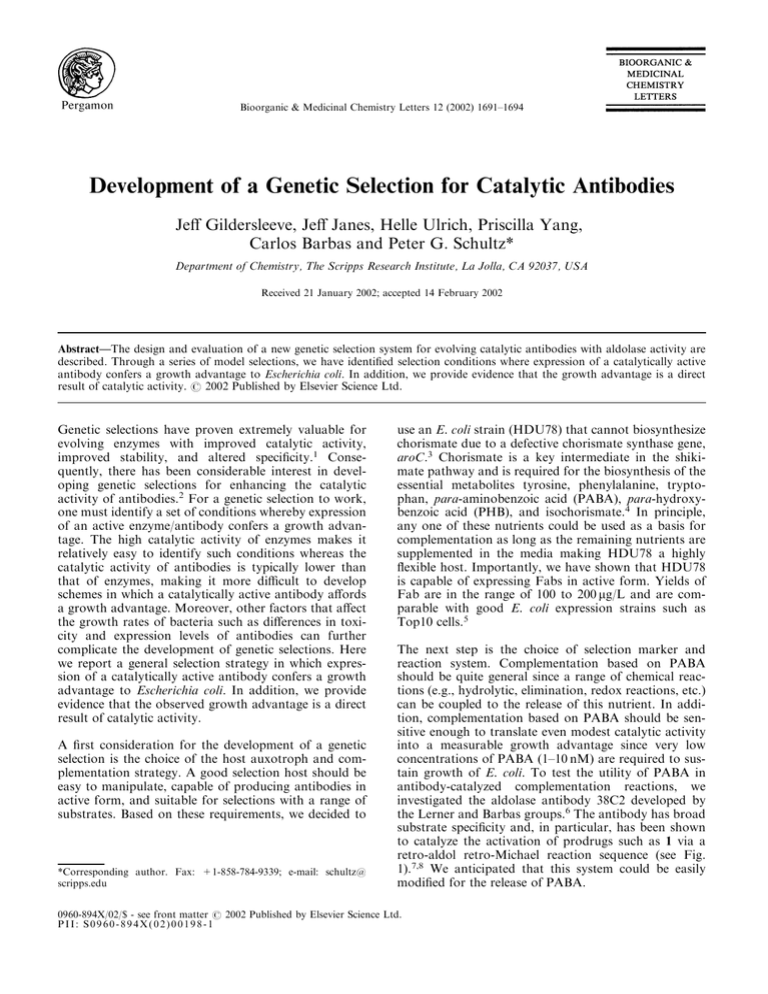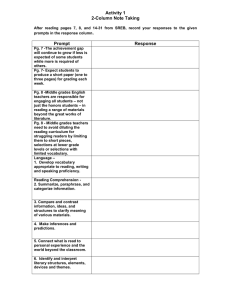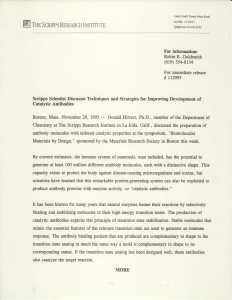Development of a Genetic Selection for Catalytic Antibodies
advertisement

Bioorganic & Medicinal Chemistry Letters 12 (2002) 1691–1694 Development of a Genetic Selection for Catalytic Antibodies Jeff Gildersleeve, Jeff Janes, Helle Ulrich, Priscilla Yang, Carlos Barbas and Peter G. Schultz* Department of Chemistry, The Scripps Research Institute, La Jolla, CA 92037, USA Received 21 January 2002; accepted 14 February 2002 Abstract—The design and evaluation of a new genetic selection system for evolving catalytic antibodies with aldolase activity are described. Through a series of model selections, we have identified selection conditions where expression of a catalytically active antibody confers a growth advantage to Escherichia coli. In addition, we provide evidence that the growth advantage is a direct result of catalytic activity. # 2002 Published by Elsevier Science Ltd. Genetic selections have proven extremely valuable for evolving enzymes with improved catalytic activity, improved stability, and altered specificity.1 Consequently, there has been considerable interest in developing genetic selections for enhancing the catalytic activity of antibodies.2 For a genetic selection to work, one must identify a set of conditions whereby expression of an active enzyme/antibody confers a growth advantage. The high catalytic activity of enzymes makes it relatively easy to identify such conditions whereas the catalytic activity of antibodies is typically lower than that of enzymes, making it more difficult to develop schemes in which a catalytically active antibody affords a growth advantage. Moreover, other factors that affect the growth rates of bacteria such as differences in toxicity and expression levels of antibodies can further complicate the development of genetic selections. Here we report a general selection strategy in which expression of a catalytically active antibody confers a growth advantage to Escherichia coli. In addition, we provide evidence that the observed growth advantage is a direct result of catalytic activity. A first consideration for the development of a genetic selection is the choice of the host auxotroph and complementation strategy. A good selection host should be easy to manipulate, capable of producing antibodies in active form, and suitable for selections with a range of substrates. Based on these requirements, we decided to *Corresponding author. Fax: +1-858-784-9339; e-mail: schultz@ scripps.edu use an E. coli strain (HDU78) that cannot biosynthesize chorismate due to a defective chorismate synthase gene, aroC.3 Chorismate is a key intermediate in the shikimate pathway and is required for the biosynthesis of the essential metabolites tyrosine, phenylalanine, tryptophan, para-aminobenzoic acid (PABA), para-hydroxybenzoic acid (PHB), and isochorismate.4 In principle, any one of these nutrients could be used as a basis for complementation as long as the remaining nutrients are supplemented in the media making HDU78 a highly flexible host. Importantly, we have shown that HDU78 is capable of expressing Fabs in active form. Yields of Fab are in the range of 100 to 200 mg/L and are comparable with good E. coli expression strains such as Top10 cells.5 The next step is the choice of selection marker and reaction system. Complementation based on PABA should be quite general since a range of chemical reactions (e.g., hydrolytic, elimination, redox reactions, etc.) can be coupled to the release of this nutrient. In addition, complementation based on PABA should be sensitive enough to translate even modest catalytic activity into a measurable growth advantage since very low concentrations of PABA (1–10 nM) are required to sustain growth of E. coli. To test the utility of PABA in antibody-catalyzed complementation reactions, we investigated the aldolase antibody 38C2 developed by the Lerner and Barbas groups.6 The antibody has broad substrate specificity and, in particular, has been shown to catalyze the activation of prodrugs such as 1 via a retro-aldol retro-Michael reaction sequence (see Fig. 1).7,8 We anticipated that this system could be easily modified for the release of PABA. 0960-894X/02/$ - see front matter # 2002 Published by Elsevier Science Ltd. PII: S0960-894X(02)00198-1 1692 J. Gildersleeve et al. / Bioorg. Med. Chem. Lett. 12 (2002) 1691–1694 Table 1. Results from the model selections Entry Figure 1. Retro-aldol retro-Michael activation of prodrug 1 and substrate 2. 1 2 3 4 5 6 7 8 Substrate (mM) Temp. ( C) Arabinosea (%) pHb Enrichment for 38C2 2 (20) 2 (10) 2 (5) 2 (1) 2 (5) 2 (5) 5 (10) 5 (10) 37 37 37 37 30 37 37 37 0.05 0.05 0.05 0.05 0.05 None 0.05 None 7.0 7.0 7.0 7.0 7.0 7.0 7.0 7.0 9 11 21 None None None None None a Selections with 0.05% and 0.005% arabinose produced similar results. b Selections were also conducted at pH 7.5 and 8.0, but pH 7.0 was found to be optimal. containing colonies to 38KM containing colonies for each of the cultures was then compared to the ratio for the starting mix. Figure 2. Synthesis of substrate 2. Reaction conditions: (a) ethyl isocyanatobenzene, toluene, 105 C (99%); (b) NaOEt, EtOH/H2O (2:1), 55 C (75%); (c) OsO4, NMO, CH2Cl2, 1 h then Pb(OAc)4 (63%). A genetic selection involving 38C2-catalyzed release of PABA requires that substrate 2 is not converted to PABA by any endogenous enzymes and the rate of the uncatalyzed reaction in culture media is sufficiently low to provide a selectable window. Substrate 2 was synthesized as shown in Figure 2 and then evaluated by comparing the growth rates of HDU78 in the presence of various concentrations of either PABA or 2.9 Approximately 1 nM PABA is required to detect growth while 10 nM PABA is required to produce normal growth of HDU78. For comparison, 1 mM 2 is required to detect growth and > 20 mM 2 is required for normal growth. These results demonstrate that the uncatalyzed rate of conversion of 2 to PABA is sufficiently low to permit selections using this substrate. Finally, compound 2 was found to be an acceptable substrate for 38C2 with similar kinetic parameters as other retroaldol-retro-Michael substrates (kcat=0.0069 min1 at 37 C, Km=150 mM).10,11 To determine if expression of an active antibody confers a growth advantage and identify the optimal growth conditions, a series of model selections were carried out with bacteria expressing 38C2. Bacteria expressing 38KM, a catalytically inactive mutant of 38C2, were used as a control.12,13 By comparing 38C2 with a closely related mutant, any differences in growth rates due to differences in toxicity, expression levels, etc. should be minimized. Bacteria expressing 38C2 and bacteria expressing 38KM were mixed and small aliquots of this stock mix were used to inoculate selection cultures. The cultures were then grown under various conditions (i.e., 1–20 mM substrate 2, 0–0.05% arabinose, pH 7.0–8.0, 30–37 C) to an OD600 of 1.0, diluted, and then regrown over approximately 30 generations.14 The starting mix and cultures were plated out on LB/amp/glucose plates and colony PCR reactions were performed with primers specific for either 38C2 or 38KM to determine the identities of individual colonies. The ratio of 38C2 The results from the model selection are summarized in Table 1. Using the best growth conditions (see Table 1, entry 3), we obtained a 21-fold enrichment of bacteria expressing 38C2 demonstrating that expression of an active antibody can confer a growth advantage using our selection system. An enrichment of 21 after growth over 30 generations indicates that bacteria expressing 38C2 have an average growth rate that is 10% faster than bacteria expressing 38KM. The growth advantage is noteworthy given the modest activity of 38C2 for substrate 2 and the concentration of 2 in the selection. It is important to note that a growth advantage of 10% or more should be sufficient for selections on antibody libraries as long as multiple rounds of selection are conducted. For example, a 10% growth advantage over 150 generations would produce an enrichment of 106. Although enrichment for bacteria expressing an active antibody over bacteria expressing an inactive antibody was observed, this result alone did not rule out the possibility that the difference in growth rates was a result of subtle differences in toxicity, expression levels, etc., between the antibodies. However, no enrichment could be detected in the absence of Fab expression (i.e., no induction with arabinose – see Table 1, entry 6), and no enrichment could be detected when cells were grown in the presence of 5 (an isostere of 2 that is not a substrate for 38C2, see entry 7). These additional experiments provide evidence that the growth advantage is a direct result of catalytic activity. In summary, we have developed a new genetic selection system for catalytic antibodies based on complementation of an E. coli auxotroph lacking chorismate synthase activity. Through a series of model selections, we have successfully identified selection conditions where expression of a catalytically active antibody confers a growth advantage. In addition, we provide evidence that the growth advantage is a direct result of catalytic activity. It is important to note that the selection system is sensitive enough to translate even modest catalytic activity into a measurable growth advantage. By generating large combinatorial libraries of antibodies and J. Gildersleeve et al. / Bioorg. Med. Chem. Lett. 12 (2002) 1691–1694 conducting iterative rounds of selection and DNA shuffling, we hope to identify highly active aldolase antibodies. Acknowledgements This research was supported by the National Institutes of Health (GM56528). J.G. gratefully acknowledges a postdoctoral fellowship from the NIH (Grant No. 5 F32 AI10419). J.J. gratefully acknowledges a pre-doctoral fellowship from the Howard Hughes Medical Institute. The authors also wish to thank Professor R.A. Lerner for a generous gift of 38C2 IgG. This is manuscript number 14412-CH of The Scripps Research Institute. References and Notes 1. For a recent review, see: Kasr, P.; Hilvert, D. Pure Appl. Chem. 1996, 68, 2017. 2. (a) For previous work on the development of genetic selections for catalytic antibodies, see: Tang, Y.; Hicks, J. B.; Hilvert, D. Proc. Natl. Acad. Sci. U.S.A. 1991, 88, 8784. (b) Lesley, S. A.; Patten, P. A.; Schultz, P. G. Proc. Natl. Acad. Sci. U.S.A. 1993, 90, 1160. (c) Smiley, S. J.; Benkovic Proc. Natl. Acad. Sci. U.S.A. 1994, 91, 8319. 3. E. coli strain HDU78 [hdsF mcr13 araD13 9 (araABCleu) 7679 D LacX74 galU galK rpsL thi- aroC purF::Tn10] was generated from strain MC1061 [hdsF mcr13 araD139 D(araABC-leu)7679 D LacX74 galU galK rpsL thi-] through a series of P1 transductions. Briefly, a P1 lysate was prepared from strain NK6073 (obtained from B. Bachmann, E. coli Genetic Stock Centre) which contains a tetracycline resistance marker (TetR) in the form of a transposable element (purF::Tn10) close to the wild type aroC locus. This lysate was used to introduce the TetR marker into AB2849 (B. Bachmann), an E. coli strain that carries a defective chorismate synthase gene (aroC ). A resulting strain possessing both the TetR marker and the aroC auxotrophy (HDU73) was used to transduce the aroC TetR combination into strain MC1061 to produce HDU78. 4. Walsh, C. T.; Lui, J.; Rusnak, R.; Sakaitani, M. Chem. Rev. 1990, 90, 1105. 5. Ulrich, H. D.; Patten, P. A.; Yang, P. L.; Romesberg, F. E.; Schultz, P. G. Proc. Natl. Acad. Sci. U.S.A. 1995, 92, 11907. 6. For a lead reference see: Wagner, J.; Lerner, R. A.; Barbas, C. F., III Science 1995, 270, 1797. 7. Shabat, D.; Rader, C.; List, B.; Lerner, R. A.; Barbas, C. F., III Proc. Natl. Acad. Sci. U.S.A. 1999, 96, 6925. 8. While 38C2 catalyzes both steps of prodrug activation, the retro-aldol reaction is the rate-determining step. 9. Experimental data for compounds 2, 4, and 5 are listed below. Compound 2: Rf 0.30 (25% acetone/chloroform +0.5% acetic acid); 1H NMR (CDCl3+5% CD3OD, 250 MHz) d 8.31 (br s, 1H), 7.99 (d, J=8.8 Hz, 2H), 7.50 (d, J=8.8 Hz, 2H), 4.32 (t, J=6.9 Hz, 2H), 2.70 (m, H), 2.20 (s, 3H), 1.85–2.01 (m, 2H), 1.30 (s, 3H); 13C NMR (CDCl3, 62.5 MHz) d 210.2, 167.8, 154.2, 145.2, 132.1, 125.8, 118.8, 71.3, 62.9, 54.5, 41.6, 32.5, 28.2; MALDI FTMS calcd for C15H19NO6Na (M+Na+) 332.1105, found 332.1098. Compound 4: Rf 0.30 (30% ethylacetate/hexane); 1H NMR (CDCl3, 250 MHz) d 7.99 (d, J=8.8 Hz, 2H), 7.48 (d, J=8.8 Hz, 2H), 7.25 (br s, 1H), 4.96 (br s, 1H), 4.77 (br s, 1H), 4.30–4.50 (m, 4H), 2.26 (d, J=13.5 Hz, 1H), 2.20 (d, J=13.5 Hz, 1H), 2.1 (br s, 1H), 1.86–1.95 (m, 2H), 1.84 (s, 3H), 1.38 (t, 7.0 Hz, 1693 3H), 1.25 (s, 3H); 13C NMR (CDCl3, 62.5 MHz) d 166.2, 153.2, 142.1, 130.8, 125.0, 117.5, 115.4, 77.2, 71.4, 62.2, 60.8, 50.0, 40.5, 27.1, 24.9, 14.3; MALDI FTMS calcd for C18H25NO5Na (M+Na+) 358.1625, found 358.1619. Compound 5: Rf 0.30 (20% acetone/chloroform +0.5% acetic acid); 1H NMR (CDCl3, 250 MHz) d 8.08 (d, J=8.8 Hz, 2H), 7.52 (d, J=8.8 Hz, 2H), 7.10 (br s, 1H), 4.97 (br s, 1H), 4.78 (br s, 1H), 4.35–4.45 (m, 2H), 2.27 (d, J=13.3 Hz, 1H), 2.22 (d, J=13.3 Hz, 1H), 1.87–1.99 (m, 2H), 1.85 (s, 3H), 1.28 (s, 3H); 13C NMR (acetone-d6, 62.5 MHz) d 167.9, 154.9, 145.3, 144.7, 132.2, 125.7, 118.8, 115.3, 72.2, 63.3, 51.7, 42.1, 29.5, 28.1; MALDI FTMS calcd for C16H21NO5Na (M+Na+) 330.1312, found 330.1315. 10. Initial reaction rates for the retro-aldol-retro-Michael reaction of substrate 2 to PABA were measured using a reverse-phase HPLC assay. Reactions were incubated at 37 C and reaction progress was monitored by periodic injection of a 60 mL sample from the reaction mixture onto a reverse-phase C-18 HPLC column (Rainin protein and peptide C18) with UV detection at 275 nm. Products were eluted using the following conditions: buffer A=water+0.1% acetic acid, buffer B=acetonitrile+0.1% acetic acid; HPLC gradient=1.0–7 min 95:5 A:B; 2. ramp to 50:50 A:B over 3 min; 3. ramp to 20:80 A:B over 10 min; 4. ramp to 0:100 A:B over 2 min; 5. 0:100 A:B for 1 min; 6. ramp to 95:5 A:B over 2 min; 7. 95:5 A:B for 5 min. Substrate 2 and PABA had retention times of 14.3 min and 7.7 min, respectively. 11. With a kcat=0.0069 min1, 100 mg/L 38C2 Fab (2 nM) could produce 20 nM PABA in a 24 h period. 12. The expression vector for the selections, pFH4, was generated from plasmid p4xH5 as follows. First, the alkaline phosphatase promotor (PhoA) was removed by EcoRI/SpeI digestion and replaced by an insert containing the araC gene, the arabinose promotor (PBAD) and its regulatory sequences (O1, O2, I1, I2, CAP-binding site) amplified from vector pBAD/lamB (Maxygen) using primers PLY100 (50 -AGGTCGAATTCGCATAATGTGCCTGTCAAATGGA-30 ) and PLY101 (50 -AGGTCACTAGTTGATGTATATCTCCTTCTTAAAGT-30 ). The BstEII restriction site located between the O2 region and PBAD was mutated to introduce a SmaI site, leaving a unique BstEII site in the JH region of the heavy chain for cloning of VH genes. A ClaI site was similarly introduced using primer S033 (50 -CGCTTCAGCCAATACTTTATCGATTCCCGCCATTCAGAGA-30 ) between the araC and the O2 region to facilitate the diversification of the promotor region along with the Fab fragment genes in expression libraries. Finally, the stII leader peptide upstream of Vk was replaced by the pelB leader sequence using primers S044 (50 CTAGTATGAAATACCTATTGCCTACGGCAGCCGCTGGATTGTTATTACTCGCGGCCCAGCCGGCCATGGCCGAGCT-30 ) and S045 (50 -CGGCCATGGCCGGCTGGGCCGCGAGTAATAACAATCCAGCGGCTGCCGTAGGCAATAGGTATTTCATA-30 ). An optimized ribosomal binding site was also introduced in this step. 13. 38KM was produced by mutating the codon for the active site lysine (AAA, heavy chain residue 93) to ATG (coding for methionine) using a QuikChange kit (Stratagene) with primers JG1 (50 -CTGAAGACACTGGAATTTATTACTGTATGACCTATTTTTACTCATTTTCTTACTGGG-30 ) and JG2 (50 CCCAGTAAGAAAATGAGTAAAAATAGGTCATACAGTAATAAATTCCAGTGTCTTCAG-30 ). 14. Model selections were conducted as follows. A stock mixture of 38C2 and 38KM containing cells was produced by suspending a single colony of HDU78 containing the plasmid pFH4.38C2 and a single colony of HDU78 containing the plasmid pFH4.38KM in 1 mL of supplemented minimal media (M9 salts containing 0.5% glycerol, 0.8 mM ala, 5.2 mM arg, 0.4 mM asp, 0.4 mM asn, 0.1 mM cys, 0.6 mM glu, 0.6 mM gln, 0.8 mM gly, 0.2 mM his, 0.4 mM ile, 0.8 mM leu, 0.4 mM 1694 J. Gildersleeve et al. / Bioorg. Med. Chem. Lett. 12 (2002) 1691–1694 lys, 0.2 mM met, 0.4 mM phe, 0.4 mM pro, 10 mM ser, 0.4 mM thr, 0.1 mM trp, 0.2 mM tyr, 0.6 mM val, 0.01 mM thiamine, 0.01 mM pantothenate, 0.01 mM para-hydroxybenzoic acid, 0.01 mM dihydroxybenzoic acid, 0.4 mM adenine, 1 mM MgSO4, 0.1 mM CaCl2, and 0.01 mM FeSO4). This stock mix was then diluted by a factor of 50 and 50 mL of the diluted stock mix was used to inoculate each 5 mL selection culture (e.g., supplemented minimal media containing 0.05% arabinose, 70 ug/mL ampicillin, pH 7.0, and 5 mM substrate 2). Selection cultures were grown in a shaker (250 rpm, 30 C or 37 C) to an OD600=1.0, diluted into fresh selection media and then re-grown to an OD600=1.0 etc. over approximately 30 doublings. The starting stock mix and the final selection cultures were plated on LB/Amp/Glucose plates and single colonies were analyzed by two different colony PCR reactions: one containing primers jj24 (50 -AATTTTGTTTAACTTTAAGAAGGAG-30 ) and jg5 (50 -GTAAGAAAATGAGTAAAAATAGGTTT-30 , specific for 38C2) and another containing primers jj24 and jg6 (50 -GTAAGAAAATGAGTAAAAATAGGTCA-30 , specific for 38KM).



